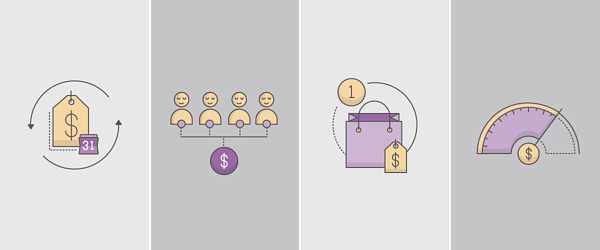Choosing the Right Billing Model for Your Subscription-based Business

As subscription based-businesses continue to evolve, they’re seeking greater control and flexibility in terms of the plans they are able to offer their subscribers and how they’re priced. A one-size-fits-all approach rarely works in any business, and subscription businesses are no exception. Customers want to know they’re getting value, and merchants want to be better able to set prices that reflect the value of their product or service. Doing this well ultimately leads to increased customer satisfaction and reduced churn.
There are several pricing models available to subscription businesses. These can include a fixed-price model, a seat-based or SaaS model, a usage-based model, and a one-time model. Each has different characteristics and strategic benefits.
The fixed recurring model sells each product or service at a set price, charged at the beginning of the billing cycle. Merchants may have a variety of plans, but the price for each plan or item in the plan is fixed. Many of the subscriptions with which people are familiar are fixed-price subscriptions, such as a monthly magazine subscription, a video streaming service, or a box-of-the-month.
One reason this model is popular with subscription-based businesses is that it provides a continuous and predictable revenue stream, since the expected revenue in each billing cycle is known and remains relatively steady. Subscribers benefit from a low cost-of-entry, since they pay a lower price on a monthly (or at some other frequency) basis rather than having to pay the full purchase price outright for access—similar to leasing rather than purchasing a new car.
The seat-based model is commonly used to provide access to cloud-based, B2B software, with the subscriber paying for each “seat” or license required to use the software. It’s similar to the fixed model, as the cost for each seat is generally fixed, but the price is frequently prorated if a new user is added after the beginning of the billing period. Or, the per-seat price may be lowered if more seats are bought.
The benefits of this model are that the price and the value are very transparent, as they’re based directly on the number of seats purchased. This also allows for predictable costs that scale with the business.
Contrast these two models with the usage-based model, where the price is based on how much the subscriber uses of the things (products or services) in their subscription plan. This model is common with businesses that are transaction-based, such as cell phone carriers, where customers pay according to their usage (such as data, minutes, or texts). Video hosting services are another business that commonly uses this model, charging subscribers for how many gigabytes of storage or hosting bandwidth they use, or by how many ad clicks they get. Under a usage-based model, billing for usage happens in arrears, after the billing period is closed and the actual usage can be measured.
The benefits of a usage-based model is the price is directly aligned with usage and therefore the value is clear, which leads to less churn. Models that require subscribers to estimate their usage and pay in advance do not offer this advantage. Subscribers who overestimate their usage end up paying more than they should have and are less satisfied. For the subscription business, this model lets them track usage and identify upsell opportunities that offer better per-unit cost savings to subscribers based on their volume. As well, this model is highly responsive to market conditions and competition.
Usage-based models are more commonly found in B2B businesses, although many B2B subscription businesses offer plans with a variety of pricing models. For example, plans may be tiered, based on expected usage, and the lower-priced plans may have a fixed recurring price, whereas Enterprise and custom plans will have usage-based pricing. In the latter case, the price may be negotiated, with different levels of usage having different per-unit prices. Higher usage levels will often warrant a lower unit cost, providing the merchant with a kind of “volume discount.”
Another model is based on a one-time charge. A subscription-based business may offer this plan as a way for prospects to try the product or service before committing to a subscription. For example, a consumer might opt to make a one-time purchase of a box-of-the-month to see if they like the selection. If they do, they may decide to become a subscriber and receive the box (or other product or service) on a recurring basis.
This “try before you buy” approach is one benefit to this model, along with the ability to test out demand for new products or services in preparation for creating a subscription plan around them. Of course, one-time charges, such as a setup fee or a charge for required equipment, can also be included as an add-on to any of the models above.
Choosing the right model
Different kinds of subscription businesses are obviously more suited to one type of model vs. another, and they may need to add or alter their model over time as their business grows and evolves. A subscription-based business may start out using a simple fixed-price model, but may find that adding a usage-based component or transitioning entirely to usage-based pricing better serves their customers and better reflects the value of their product or service.
Or, a merchant might find that charging on usage is unnecessarily granular and complicated and choose instead to offer a number of different fixed-price plans with different usage limits, as this may be easier for them to manage and easier for their customers to understand and budget for.
Whatever model a merchant needs or chooses, their subscription billing solution must be able to support it.
Usage-based billing is now available. To learn more, please visit our documentation.


